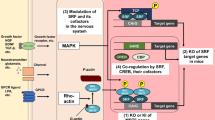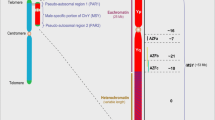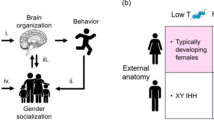Abstract
The systemic delivery of tamoxifen (Tam) to activate inducible CreERT2-loxP transgenic mouse systems is now widely used in neuroscience studies. This critical technological advancement allows temporal control of DNA-cre recombination, avoidance of embryonically lethal phenotypes, and minimization of residual cell labeling encountered in constitutively active drivers. Despite its advantages, the use of Tam has the potential to cause long-lasting, uncharacterized side effects on the transcriptome and epigenome in the CNS, given its mixed estrogen receptor (ER) agonist/antagonist actions. With the welcome focus on including both sexes in biomedical studies and efforts to understand sex differences, Tam administration could also cause sexually divergent responses that would confound studies. To examine these issues, epigenetic and transcriptomic profiles were compared in C57BL/6 J female and male hippocampus, cortex, and retina 1 month after a 5-day Tam treatment typical for cre induction, or vehicle control (sunflower seed oil). Cytosine methylation and hydroxymethylation levels, in both CG and non-CG contexts, were unchanged as determined by oxidative bisulfite sequencing. Long-lasting Tam transcriptomic effects were also not evident/minimal. Furthermore, there is no evidence of sexually divergent responses with Tam administration and Tam did not alter sex differences evident in controls. Combined with recently reported data that Tam alone does not cause long-lasting changes in behavior and neurogenesis, our findings provide confidence that Tam can be used as a cre-recombinase inducer without introducing significant confounds in transcriptomic and epigenomic neuroscience studies, particularly those focused on genomic and transcriptomic aspects of the aging brain.








Similar content being viewed by others
References
Abdelhaleem M (2005) RNA helicases: regulators of differentiation. Clin Biochem 38:499–503
Agger K, Cloos PAC, Christensen J, Pasini D, Rose S, Rappsilber J, Issaeva I, Canaani E, Salcini AE, Helin K (2007) UTX and JMJD3 are histone H3K27 demethylases involved in HOX gene regulation and development. Nature 449:731–734
Akalin A et al (2012) methylKit: a comprehensive R package for the analysis of genome-wide DNA methylation profiles. Genome Biol13:R87
Allis CD, Jenuwein T (2016) The molecular hallmarks of epigenetic control. Nat Rev Genet 17:487–500
Anders S, Huber W (2010) Differential expression analysis for sequence count data. Genome Biol 11:R106
Armoskus C, Moreira D, Bollinger K, Jimenez O, Taniguchi S, Tsai HW (2014) Identification of sexually dimorphic genes in the neonatal mouse cortex and hippocampus. Brain Res 1562:23–38
Ashpole NM, Logan S, Yabluchanskiy A, Mitschelen MC, Yan H, Farley JA, Hodges EL, Ungvari Z, Csiszar A, Chen S, Georgescu C, Hubbard GB, Ikeno Y, Sonntag WE (2017) IGF-1 has sexually dimorphic, pleiotropic, and time-dependent effects on healthspan, pathology, and lifespan. Geroscience 39:129–145
Beyer C, Pawlak J, Karolczak M (2003) Membrane receptors for oestrogen in the brain. J Neurochem 87:545–550
Blair LP, Cao J, Zou MR, Sayegh J, Yan Q (2011) Epigenetic regulation by lysine demethylase 5 (KDM5) enzymes in Cancer. Cancers (Basel) 3:1383–1404
Blurton-Jones M, Tuszynski MH (2001) Reactive astrocytes express estrogen receptors in the injured primate brain. J Comp Neurol 433:115–123
Bramham CR, Worley PF, Moore MJ, Guzowski JF (2008) The immediate early gene arc/arg3.1: regulation, mechanisms, and function. J Neurosci 28:11760–11767
Bramlett KS, Burris TP (2002) Effects of selective estrogen receptor modulators (SERMs) on coactivator nuclear receptor (NR) box binding to estrogen receptors. Mol Genet Metab 76:225–233
Chucair-Elliott AJ, Gurung HR, Carr MM, Carr DJJ (2017) Colony stimulating Factor-1 receptor expressing cells infiltrating the cornea control corneal nerve degeneration in response to HSV-1 infection. Invest Ophthalmol Vis Sci 58:4670–4682
Clayton JA, Collins FS (2014) Policy: NIH to balance sex in cell and animal studies. Nature 509:282–283
Cordin O, Banroques J, Tanner NK, Linder P (2006) The DEAD-box protein family of RNA helicases. Gene 367:17–37
Coulon V, Chebli K, Cavelier P, Blanchard JM (2010) A novel mouse c-fos intronic promoter that responds to CREB and AP-1 is developmentally regulated in vivo. PLoS One 5:e11235
Deepa SS, Bhaskaran S, Espinoza S, Brooks SV, McArdle A, Jackson MJ, van Remmen H, Richardson A (2017) A new mouse model of frailty: the cu/Zn superoxide dismutase knockout mouse. Geroscience 39:187–198
Du M et al (2017) Retinal gene expression responses to aging are sexually divergent. Mol Vis 23:707–717
Feil R, Wagner J, Metzger D, Chambon P (1997) Regulation of cre recombinase activity by mutated estrogen receptor ligand-binding domains. Biochem Biophys Res Commun 237:752–757
Fonseca MI, Chu SH, Hernandez MX, Fang MJ, Modarresi L, Selvan P, MacGregor GR, Tenner AJ (2017) Cell-specific deletion of C1qa identifies microglia as the dominant source of C1q in mouse brain. J Neuroinflammation 14:48
Fornander T, Rutqvist LE, Cedermark B, Glas U, Mattsson A, Silfverswärd C, Skoog L, Somell A, Theve T, Wilking N (1989) Adjuvant tamoxifen in early breast cancer: occurrence of new primary cancers. Lancet 1:117–120
Gao X, Castro-Gomez S, Grendel J, Graf S, Süsens U, Binkle L, Mensching D, Isbrandt D, Kuhl D, Ohana O (2018) Arc/Arg3.1 mediates a critical period for spatial learning and hippocampal networks. Proc Natl Acad Sci U S A 115:12531–12536
Garcia-Ovejero D, Azcoitia I, Doncarlos LL, Melcangi RC, Garcia-Segura LM (2005) Glia-neuron crosstalk in the neuroprotective mechanisms of sex steroid hormones. Brain Res Brain Res Rev 48:273–286
Gayen S, Maclary E, Hinten M, Kalantry S (2016) Sex-specific silencing of X-linked genes by Xist RNA. Proc Natl Acad Sci U S A 113:E309–E318
Hadad N, Masser DR, Logan S, Wronowski B, Mangold CA, Clark N, Otalora L, Unnikrishnan A, Ford MM, Giles CB, Wren JD, Richardson A, Sonntag WE, Stanford DR, Freeman W (2016) Absence of genomic hypomethylation or regulation of cytosine-modifying enzymes with aging in male and female mice. Epigenetics Chromatin 9:30
Haynes B, Dowsett M (1999) Clinical pharmacology of selective estrogen receptor modulators. Drugs Aging 14:323–336
Heiman M, Schaefer A, Gong S, Peterson JD, Day M, Ramsey KE, Suárez-Fariñas M, Schwarz C, Stephan DA, Surmeier DJ, Greengard P, Heintz N (2008) A translational profiling approach for the molecular characterization of CNS cell types. Cell 135:738–748
Holliday R (2006) Epigenetics: a historical overview. Epigenetics 1:76–80
Horvath S, Zhang Y, Langfelder P, Kahn RS, Boks MPM, van Eijk K, van den Berg LH, Ophoff RA (2012) Aging effects on DNA methylation modules in human brain and blood tissue. Genome Biol 13:R97
Imperio CG, McFalls AJ, Colechio EM, Masser DR, Vrana KE, Grigson PS, Freeman WM (2016) Assessment of individual differences in the rat nucleus accumbens transcriptome following taste-heroin extended access. Brain Res Bull 123:71–80
Indra AK, Warot X, Brocard J, Bornert JM, Xiao JH, Chambon P, Metzger D (1999) Temporally-controlled site-specific mutagenesis in the basal layer of the epidermis: comparison of the recombinase activity of the tamoxifen-inducible Cre-ER(T) and Cre-ER(T2) recombinases. Nucleic Acids Res 27:4324–4327
Jahn HM, Kasakow CV, Helfer A, Michely J, Verkhratsky A, Maurer HH, Scheller A, Kirchhoff F (2018) Refined protocols of tamoxifen injection for inducible DNA recombination in mouse astroglia. Sci Rep 8:5913
Karlsson S (2006) Histopathology and histomorphometry of the urogenital tract in 15-month old male and female rats treated neonatally with SERMs and estrogens. Exp Toxicol Pathol 58:1–12
Keshet Y, Seger R (2010) The MAP kinase signaling cascades: a system of hundreds of components regulates a diverse array of physiological functions. Methods Mol Biol 661:3–38
Khalaj AJ, Yoon J, Nakai J, Winchester Z, Moore SM, Yoo T, Martinez-Torres L, Kumar S, Itoh N, Tiwari-Woodruff SK (2013) Estrogen receptor (ER) beta expression in oligodendrocytes is required for attenuation of clinical disease by an ERbeta ligand. Proc Natl Acad Sci U S A 110:19125–19130
Kopsida E, Stergiakouli E, Lynn PM, Wilkinson LS, Davies W (2009) The role of the Y chromosome in brain function. Open Neuroendocrinol J 2:20–30
Krueger F, Andrews SR (2011) Bismark: a flexible aligner and methylation caller for bisulfite-Seq applications. Bioinformatics 27:1571–1572
Kuiper GG et al (1997) Comparison of the ligand binding specificity and transcript tissue distribution of estrogen receptors alpha and beta. Endocrinology 138:863–870
Law JA, Jacobsen SE (2010) Establishing, maintaining and modifying DNA methylation patterns in plants and animals. Nat Rev Genet 11:204–220
Lee MG, Villa R, Trojer P, Norman J, Yan KP, Reinberg D, Croce LD, Shiekhattar R (2007) Demethylation of H3K27 regulates polycomb recruitment and H2A ubiquitination. Science 318:447–450
Lister R, Mukamel EA, Nery JR, Urich M, Puddifoot CA, Johnson ND, Lucero J, Huang Y, Dwork AJ, Schultz MD, Yu M, Tonti-Filippini J, Heyn H, Hu S, Wu JC, Rao A, Esteller M, He C, Haghighi FG, Sejnowski TJ, Behrens MM, Ecker JR (2013) Global epigenomic reconfiguration during mammalian brain development. Science 341:1237905
Lu YP, Zeng M, Hu XY, Xu H, Swaab DF, Ravid R, Zhou JN (2003) Estrogen receptor alpha-immunoreactive astrocytes are increased in the hippocampus in Alzheimer's disease. Exp Neurol 183:482–488
Maegawa S, Hinkal G, Kim HS, Shen L, Zhang L, Zhang J, Zhang N, Liang S, Donehower LA, Issa JPJ (2010) Widespread and tissue specific age-related DNA methylation changes in mice. Genome Res 20:332–340
Malonia SK et al (2011) Gene regulation by SMAR1: role in cellular homeostasis and cancer. Biochim Biophys Acta 1815:1–12
Mangold CA, Masser DR, Stanford DR, Bixler GV, Pisupati A, Giles CB, Wren JD, Ford MM, Sonntag WE, Freeman WM (2017a) CNS-wide sexually dimorphic induction of the major histocompatibility complex 1 pathway with aging. J Gerontol A Biol Sci Med Sci 72:16–29
Mangold CA, Wronowski B, du M, Masser DR, Hadad N, Bixler GV, Brucklacher RM, Ford MM, Sonntag WE, Freeman WM (2017b) Sexually divergent induction of microglial-associated neuroinflammation with hippocampal aging. J Neuroinflammation 14:141
Marin R, Ramirez CM, Gonzalez M, Alonso R, Diaz M (2006) Alternative estrogen receptors homologous to classical receptor alpha in murine neural tissues. Neurosci Lett 395:7–11
Masser DR, Bixler GV, Brucklacher RM, Yan H, Giles CB, Wren JD, Sonntag WE, Freeman WM (2014) Hippocampal subregions exhibit both distinct and shared transcriptomic responses to aging and nonneurodegenerative cognitive decline. J Gerontol A Biol Sci Med Sci 69:1311–1324
Masser DR, Hadad N, Porter HL, Mangold CA, Unnikrishnan A, Ford MM, Giles CB, Georgescu C, Dozmorov MG, Wren JD, Richardson A, Stanford DR, Freeman WM (2017) Sexually divergent DNA methylation patterns with hippocampal aging. Aging Cell 16:1342–1352
Masser DR, Hadad N, Porter H, Stout MB, Unnikrishnan A, Stanford DR, Freeman WM (2018) Analysis of DNA modifications in aging research. Geroscience 40:11–29
Maximov PY, Lee TM, Jordan VC (2013) The discovery and development of selective estrogen receptor modulators (SERMs) for clinical practice. Curr Clin Pharmacol 8:135–155
Mazeyrat S, Saut N, Sargent CA, Grimmond S, Longepied G, Ehrmann IE, Ellis PS, Greenfield A, Affara NA, Mitchell MJ (1998) The mouse Y chromosome interval necessary for spermatogonial proliferation is gene dense with syntenic homology to the human AZFa region. Hum Mol Genet 7:1713–1724
Mazeyrat S, Saut N, Grigoriev V, Mahadevaiah SK, Ojarikre OA, Rattigan Á, Bishop C, Eicher EM, Mitchell MJ, Burgoyne PS (2001) A Y-encoded subunit of the translation initiation factor Eif2 is essential for mouse spermatogenesis. Nat Genet 29:49–53
McCarthy MM, Arnold AP, Ball GF, Blaustein JD, De Vries GJ (2012) Sex differences in the brain: the not so inconvenient truth. J Neurosci 32:2241–2247
Mizukami H, Kim JD, Tabara S, Lu W, Kwon C, Nakashima M, Fukamizu A (2019) KDM5D-mediated H3K4 demethylation is required for sexually dimorphic gene expression in mouse embryonic fibroblasts. J Biochem 165:335–342
Mo A, Mukamel EA, Davis FP, Luo C, Henry GL, Picard S, Urich MA, Nery JR, Sejnowski TJ, Lister R, Eddy SR, Ecker JR, Nathans J (2015) Epigenomic signatures of neuronal diversity in the mammalian brain. Neuron 86:1369–1384
Morales-Otal A, Retana-Marquez S, Ferreira-Nuno A, Velazquez-Moctezuma J (2005) Testosterone levels and histological features of reproductive glands in adult male rats treated neonatally with tamoxifen. Neuro Endocrinol Lett 26:729–732
Newhouse P, Dumas J (2015) Estrogen-cholinergic interactions: implications for cognitive aging. Horm Behav 74:173–185
Nugent BM, Wright CL, Shetty AC, Hodes GE, Lenz KM, Mahurkar A, Russo SJ, Devine SE, McCarthy MM (2015) Brain feminization requires active repression of masculinization via DNA methylation. Nat Neurosci 18:690–697
Park YM, Chun H, Shin JI, Lee CJ (2018) Astrocyte specificity and coverage of hGFAP-CreERT2 [Tg(GFAP-Cre/ERT2)13Kdmc] mouse line in various brain regions. Exp Neurobiol 27:508–525
Patel SH, O’Hara L, Atanassova N, Smith SE, Curley MK, Rebourcet D, Darbey AL, Gannon AL, Sharpe RM, Smith LB (2017) Low-dose tamoxifen treatment in juvenile males has long-term adverse effects on the reproductive system: implications for inducible transgenics. Sci Rep 7:8991
Pfaffl MW, Lange IG, Daxenberger A, Meyer HH (2001) Tissue-specific expression pattern of estrogen receptors (ER): quantification of ER alpha and ER beta mRNA with real-time RT-PCR. APMIS 109:345–355
Podlutsky A, Valcarcel-Ares MN, Yancey K, Podlutskaya V, Nagykaldi E, Gautam T, Miller RA, Sonntag WE, Csiszar A, Ungvari Z (2017) The GH/IGF-1 axis in a critical period early in life determines cellular DNA repair capacity by altering transcriptional regulation of DNA repair-related genes: implications for the developmental origins of cancer. Geroscience 39:147–160
Rakyan VK, Down TA, Maslau S, Andrew T, Yang TP, Beyan H, Whittaker P, McCann OT, Finer S, Valdes AM, Leslie RD, Deloukas P, Spector TD (2010) Human aging-associated DNA hypermethylation occurs preferentially at bivalent chromatin domains. Genome Res 20:434–439
Riggs BL, Hartmann LC (2003) Selective estrogen-receptor modulators -- mechanisms of action and application to clinical practice. N Engl J Med 348:618–629
Roh HC, Tsai LTY, Lyubetskaya A, Tenen D, Kumari M, Rosen ED (2017) Simultaneous transcriptional and Epigenomic profiling from specific cell types within heterogeneous tissues in vivo. Cell Rep 18:1048–1061
Rotheneichner P et al (2017) Tamoxifen activation of Cre-recombinase has no persisting effects on adult neurogenesis or learning and anxiety. Front Neurosci 11:27
Sakuma S, Tokuhara D, Hattori H, Matsuoka O, Yamano T (2009) Expression of estrogen receptor alpha and beta in reactive astrocytes at the male rat hippocampus after status epilepticus. Neuropathology 29:55–62
Sanz E, Yang L, Su T, Morris DR, McKnight GS, Amieux PS (2009) Cell-type-specific isolation of ribosome-associated mRNA from complex tissues. Proc Natl Acad Sci U S A 106:13939–13944
Snell DM, Turner JMA (2018) Sex chromosome effects on male-female differences in mammals. Curr Biol 28:R1313–R1324
Srinivasan R, Lu TY, Chai H, Xu J, Huang BS, Golshani P, Coppola G, Khakh BS (2016) New transgenic mouse lines for selectively targeting astrocytes and studying calcium signals in astrocyte processes in situ and in vivo. Neuron 92:1181–1195
Su CY, Lin TC, Lin YF, Chen MH, Lee CH, Wang HY, Lee YC, Liu YP, Chen CL, Hsiao M (2015) DDX3 as a strongest prognosis marker and its downregulation promotes metastasis in colorectal cancer. Oncotarget 6:18602–18612
Sultan M, Dökel S, Amstislavskiy V, Wuttig D, Sültmann H, Lehrach H, Yaspo ML (2012) A simple strand-specific RNA-Seq library preparation protocol combining the Illumina TruSeq RNA and the dUTP methods. Biochem Biophys Res Commun 422:643–646
Sun M, Song L, Li Y, Zhou T, Jope RS (2008) Identification of an antiapoptotic protein complex at death receptors. Cell Death Differ 15:1887–1900
Suuronen T, Nuutinen T, Huuskonen J, Ojala J, Thornell A, Salminen A (2005) Anti-inflammatory effect of selective estrogen receptor modulators (SERMs) in microglial cells. Inflamm Res 54:194–203
Taefehshokr S, Key YA, Khakpour M, Dadebighlu P, Oveisi A (2017) Early growth response 2 and Egr3 are unique regulators in immune system. Cent Eur J Immunol 42:205–209
Takahashi N, Tonchev AB, Koike K, Murakami K, Yamada K, Yamashima T, Inoue M (2004) Expression of estrogen receptor-beta in the postischemic monkey hippocampus. Neurosci Lett 369:9–13
Tee MK et al (2004) Estradiol and selective estrogen receptor modulators differentially regulate target genes with estrogen receptors alpha and beta. Mol Biol Cell 15:1262–1272
Unnikrishnan A, Jackson J, Matyi SA, Hadad N, Wronowski B, Georgescu C, Garrett KP, Wren JD, Freeman WM, Richardson A (2017) Role of DNA methylation in the dietary restriction mediated cellular memory. Geroscience 39:331–345
van Leeuwen FE, van den Belt-Dusebout AW, van Leeuwen FE, Benraadt J, Diepenhorst FW, van Tinteren H, Coebergh JWW, Kiemeney LALM, Gimbrère CHF, Otter R, Schouten LJ, Damhuis RAM, Benraadt J, Bontenbal M (1994) Risk of endometrial cancer after tamoxifen treatment of breast cancer. Lancet 343:448–452
Wardell SE, Nelson ER, McDonnell DP (2014) From empirical to mechanism-based discovery of clinically useful selective estrogen receptor modulators (SERMs). Steroids 90:30–38
Webb P, Nguyen P, Kushner PJ (2003) Differential SERM effects on corepressor binding dictate ERalpha activity in vivo. J Biol Chem 278:6912–6920
Wen L, Li X, Yan L, Tan Y, Li R, Zhao Y, Wang Y, Xie J, Zhang Y, Song C, Yu M, Liu X, Zhu P, Li X, Hou Y, Guo H, Wu X, He C, Li R, Tang F, Qiao J (2014) Whole-genome analysis of 5-hydroxymethylcytosine and 5-methylcytosine at base resolution in the human brain. Genome Biol 15:R49
Xu J, Watkins R, Arnold AP (2006) Sexually dimorphic expression of the X-linked gene Eif2s3x mRNA but not protein in mouse brain. Gene Expr Patterns 6:146–155
Xu J, Deng X, Watkins R, Disteche CM (2008) Sex-specific differences in expression of histone demethylases Utx and Uty in mouse brain and neurons. J Neurosci 28:4521–4527
Acknowledgements
The authors acknowledge the Laboratory for Molecular Biology and Cytometry Research at OUHSC for the use of the Core Facility which provided Illumina MiSeq Next Generation Sequencing services and the Oklahoma Medical Research Foundation Clinical Genomics Center which provided NextSeq services Computing for this project was performed at the OU Supercomputing Center for Education and Research (OSCER) at the University of Oklahoma (OU).
Support
This work was supported by grants from the National Institutes of Health (NIH) P30AG050911, R56AG059430, R01AG58430, P20GM125528, R01AG0256161, Veterans Affairs I01BX003906, Oklahoma Center for Adult Stem Cell Research (OCASCR) grant through the Oklahoma Tobacco Settlement Endowment Trust, and Presbyterian Health Foundation.
Author information
Authors and Affiliations
Corresponding author
Additional information
Publisher’s note
Springer Nature remains neutral with regard to jurisdictional claims in published maps and institutional affiliations.
Electronic supplementary material
ESM 1
(DOCX 516 kb).
About this article
Cite this article
Chucair-Elliott, A.J., Ocanas, S.R., Stanford, D.R. et al. Tamoxifen induction of Cre recombinase does not cause long-lasting or sexually divergent responses in the CNS epigenome or transcriptome: implications for the design of aging studies. GeroScience 41, 691–708 (2019). https://doi.org/10.1007/s11357-019-00090-2
Received:
Accepted:
Published:
Issue Date:
DOI: https://doi.org/10.1007/s11357-019-00090-2




